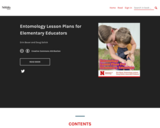
This is a collection of lesson plans on entomology for elementary educators
- Subject:
- Biology
- Life Science
- Material Type:
- Lesson Plan
- Provider:
- University of Nebraska Pressbooks
- Author:
- Ivy Grob
- Date Added:
- 08/22/2021

This is a collection of lesson plans on entomology for elementary educators
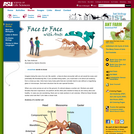
Imagine being the size of an ant. Be careful - a face-to-face encounter with an ant would be scary and potentially life-threatening! But, if you avoided being eaten, you could learn a lot about ant anatomy from a close-up view. Ants have many body parts that are normally hard to see without a magnifying glass or microscope. And each structure has its own special function.

This video on phenology of plants and bees discusses the MODIS satellite finding that springtime greening is happening one half-day earlier each year and correlates this to bee pollination field studies.
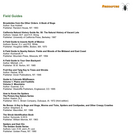
This reference includes individual titles of note along with the most popular field guide series. For each guide, the author, publisher, and publication date are given. The diverse list has 17 individual titles, which cover everything from wildflowers in the Colorado mountains and insects north of Mexico to the natural history of vacant lots. There are detailed descriptions of four of the most popular field guide series: Audubon Society Guides, Golden Guides, Peterson Guides, and Stokes Nature Guide Series.
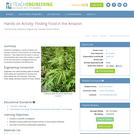
In this activity, the students will investigate a variety of plants and animals common to the Amazon through research. They will determine the plant or animal characteristics that make them edible or useful for the trip and learn to categorize them by comparing similarities and/or differences.
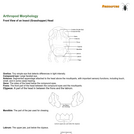
This illustrated guide to a grasshopper's head is designed to help students recognize and learn the many parts found on an insect's head. The single Web page, which can be easily printed for use at field sites or in the lab, also includes a short description for the following labeled parts: ocellus compound eye antenna gena frons clypeus mandible labrum labium palps.
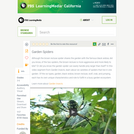
In this video segment from Garden Insects, learn about six varieties of spiders that live in one garden.
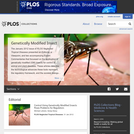
The January 2012 issue of PLOS Neglected Tropical Diseases presented an Editorial, a Viewpoint, and two accompanying Expert Commentaries that focussed on the application of genetically modified (GM) insects for control of animal and plant diseases. These articles describe the technological advances these tools represent, the regulatory framework, and the societal dialogue that is necessary for their wide-scale application for disease control. Here, we have assembled a collection of articles published in the PLOS journals that describe the technical and applied aspects of GM insects. We also included articles that are not strictly GM, but aim to modify the disease transmission traits of insects through the use of symbiotic microbes.
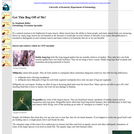
It's a natural reaction to be frightened of some insects. Many insects have the ability to harm people, and many insects look very menacing. However, many large insects are not harmful at all. Because it would take several volumes to describe every insect, this publication is intended to distinguish several common insects and insect relatives in Kentucky that are or are not harmful.

This resource is a video abstract of a research paper created by Research Square on behalf of its authors. It provides a synopsis that's easy to understand, and can be used to introduce the topics it covers to students, researchers, and the general public. The video's transcript is also provided in full, with a portion provided below for preview:
"G protein-coupled receptors, or GPCRs, are cell membrane receptors that bind to various molecules. Upon binding, GPCRs are known to undergo structural changes, which activates them for signaling between cells, but only recently have researchers begun to understand the functions and pathways of GPCRs in animals. Extensive evidence suggests that animal steroids, including estrogen, activate GPCRs. The receptor GPER1, for example, facilitates estrogen signaling but may also play a neuroprotective role, making it an attractive drug target. In insects, the hormone 20E binds to GPCRs to signal molting and metamorphosis. Understanding how to disrupt this signaling could lead to precision chemicals that control pest insects. Much work remains to map out the numerous hormone pathways orchestrated by GPCRs. Future and ongoing studies could help scientists develop pharmaceuticals that tap into these pathways to improve human health and productivity..."
The rest of the transcript, along with a link to the research itself, is available on the resource itself.
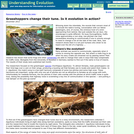
Whizzing down the interstate, the sounds that concern most of us include the radio's tuning, conversation with our fellow passengers, and, of course, the ominous howl of a siren approaching from behind. But just outside the car door, the soundscape is quite different. On busy thoroughfares, traffic noise approximates a non-stop, low-pitched roar that necessitates shouting to communicate if one is unlucky enough to need to change a tire at the side of the road. Now, new research shows that it is not just humans who strain to be heard over the din of a highway ...
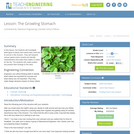
In this lesson, the students will investigate what types of plants and insects they could eat to survive in the Amazon. They will research various plants and/or insects and identify characteristics that make them edible or useful for the trip. The students will create posters and present their findings to the class.
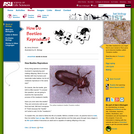
Every living thing must be able to reproduce and make offspring. Most of us are familiar with how humans and mammals make babies, but do all creatures reproduce in the same way? Do insects, like the beetle, give birth to little insects? Also in: French | Spanish

In this lesson, we learn how insects can fly in the rain. The objective is to calculate the impact forces of raindrops on flying mosquitoes. Students will gain experience with using Newton's laws, gathering data from videos and graphs, and most importantly, the utility of making approximations. No calculus will be used in this lesson, but familiarity with torque and force balances is suggested. No calculators will be needed, but students should have pencil and paper to make estimations and, if possible, copies of the graphs provided with the lesson. Between lessons, students are recommended to discuss the assignments with their neighbors.
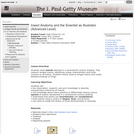
Students study insects depicted in a seventeenth-century drawing. They research winged insects, identifying unique characteristics and those common to all insects. Students closely observe winged insects and create detailed drawings of wings.

Students observe live insects and examine insects depicted in a seventeenth-century drawing. They identify the three characteristics of an adult insect: a three-part body (head, thorax, and abdomen), six legs, and antennae. They collect and draw live insects, incorporating a variety of shapes and lines.
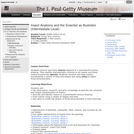
Students observe and study insects depicted in a seventeenth-century drawing. They identify characteristics common to all insects and those unique to particular species. Students research and draw insects, incorporating a variety of lines and shapes and using value to depict three-dimensionality.

This activity is a field investigation or bio-blitz where students are collecting as many different types of insects as they can. Back in the lab, they will record their findings, sort and classify the insects found. This will lead into a class discussion on biodiversity and the importance of insects and their benefits all living things.
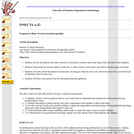
Students will use the Internet and other resources to find insect common names that begin with each letter of the alphabet.
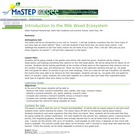
This activity is an inquiry and field study based. Students will be trying to observe, document, compare, contrast, and communicate what information they were able to gather. The will use this information to make in inference about the organisms they have found and classify them as either an insect or not an insect.